Rome Tours
Monumental Rome | Archaeological | St. Peter Basilica, the Vatican and Sistine Chapel | Trevi Fountain, the Catacombs, Appian Way, Borghese Gallery
The Vatican City, Museum-Sistine Chapel, Basilica of St. Peter
The capital of italy is probably the most visited city in the world. Whilst, arguably, for the Italians Rome is primarily the political centre of the nation, for others it is its wealth of architectural and artistic treasures which makes it a truly remarkable and unforgettable city. The numerous museums, monuments and churches, not to mention the archeological sites, represent a cultural heritage so vast that a whole lifetime would not be sufficient to explore it in its entirety.
This is why if you come to Roma...non basta una vita per visitarla, is not enough a life time to visit the Eternal City.
Suggested day tour of Rome with the visit of St. Peter in Chains, St. Clemente-underground- Rome, Coliseum, Aventino Hill, Vatican Museum-Sistine Chapel and St .Peter's Basilica, the service is driver/guided and is individually personalized.
Monumental Rome | Archaeological | St. Peter Basilica, the Vatican and Sistine Chapel | Trevi Fountain, the Catacombs, Appian Way, Borghese Gallery
The Vatican City, Museum-Sistine Chapel, Basilica of St. Peter
The capital of italy is probably the most visited city in the world. Whilst, arguably, for the Italians Rome is primarily the political centre of the nation, for others it is its wealth of architectural and artistic treasures which makes it a truly remarkable and unforgettable city. The numerous museums, monuments and churches, not to mention the archeological sites, represent a cultural heritage so vast that a whole lifetime would not be sufficient to explore it in its entirety.
This is why if you come to Roma...non basta una vita per visitarla, is not enough a life time to visit the Eternal City.
Suggested day tour of Rome with the visit of St. Peter in Chains, St. Clemente-underground- Rome, Coliseum, Aventino Hill, Vatican Museum-Sistine Chapel and St .Peter's Basilica, the service is driver/guided and is individually personalized.
| Basilica of S. Peter in Chains. San Pietro in Vincoli (Saint Peter in Chains) is a small basilica in Rome, founded in the 5th century to house the reported chains that bound St. Peter in Jerusalem. Even more famous than the chains of Saint Peter is Michelangelo's statue Moses, part of the Tomb of Pope Julius II. The basilica was first built in the middle of the 5th century to house the relic of the chains that bound Saint Peter while imprisoned in Jerusalem. According to legend, when Empress Eudoxia (wife of Emperor Valentiniano III) gave Pope Leo I the chains as a gift, he compared them to the chains of St. Peter's first imprisonment in the Mamertine Prison in Rome and the two chains miraculously fused together. The chains are kept in a reliquary under the main altar in the basilica. The basilica has undergone several restorations and rebuildings, including a restoration by Pope Adrian I, a rebuilding by Pope Sixtus IV and another by Pope Julius II. There was also a renovation in 1875. Some modernizations were made at that time. Michelangelo's Moses, which dates from 1515, is the most notable piece of artwork in the basilica. Originally intended as part of a 40-statue funeral monument for Pope Julius II, "Moses" became the Pope's funeral monument and tomb in his family's church. |
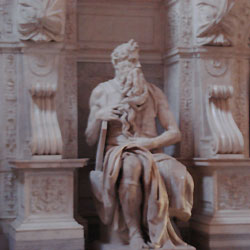 |
| Basilica of St. Clement. The Basilica of St. Clement was mentioned by St. Jerome in the 4th century, is one of the most interesting in Rome from an artistic and archaeological point of view. It was almost buried under the enormous quantity of debris accumulated in that zone after the terrible fire caused by the Normans in the 11th century, but was rebuilt in the 12th century by Paschal II on higher level. The new Basilica was built in the original form with all the architectural elements it was possible to save, so that it remains, in spite of restorations and modification of more recent date, a rare example of a typical early Christian basilica. To admire of this Basilica dated 12th century is the mosaics on the apse which, in a prodigious synthesis of Christian and pagan figurative elements, portray the Scene of the Redemption of Roman school, the Candelabra, the Schola Cantorum and more. There are notable works of art of the renaissance in this basilica, masterpieces of Masolino and Masaccio. During the excavations in the underground basilica of the 4th century, which took place in the 18th and 19th century was brougth to light by the archaeologist other Imperial and Republican constructions including a " Mithraeum", a grotto shaped room devoted to the worship of the Persian god Mithra. Mithraism, which was wide spread in the 3rd century in Rome, was a mystery religion with ritual similiar in some ways to that of Christianity. This place today is also of extraordinary interest to archaeologist. |
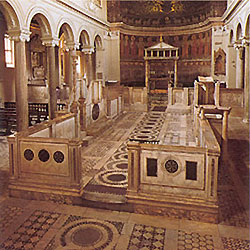 |
| Coliseum and the Arch of Constantine. The Anfiteatro Flavio, known throughout the world, the Coliseum is symbolic of the city of Rome. It is 50 meters high, 86 meters long and 54 meters wide, distributed on a structure of elliptic form. It was built under the rule of the Emperor Vespasiano on an artificial lake in 79 A.D. The Coliseum was inaugurated by Tito and became the theatre of frighteningly cruel games, in which gladiators fought each other and lions were let loose on human beings who were destined to be mauled to death. In the lower part of the Coliseum one can see the underground passages and the tunnels where the lions were kept. The Coliseum was later used as a source of materials for building works. Near to the Coliseum one finds Costantino's Arch which has to be the best example of the "recycling" carried out during the crisis of the Massenzio Empire in 312 A.D. The Domus Area, once the residential quarters of Nerone which were built after the terrible fire of 64 A.D., is close by in the Colle Oppio Park. |
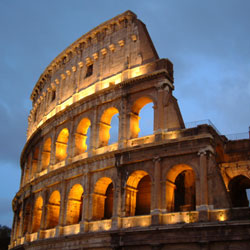 |
| Vatican Museum - Sistine Chapel. The best known of the artworks within the Vatican Museums is the Sistine Chapel ceiling fresco by Michelangelo which depicts The Last Judgement and the frescoes on the lateral walls by Pinturicchio, Perugino, Botticelli, Signorelli, Ghirlandaio and many others. Finally, one can visit the Sacred Museum and the Apostolic Library, and then the Vatican Pinacoteca which lost many of its paintings when it was pillaged by Napoleon. The Vatican Museums include the Etruscan Museum, the Egyptian Museum, the Pio Clementino Museum and the Borgia Apartment. Following the route from the entrance, one can visit the Candelabri Gallery, the Arazzi gallery, the Gallery of Geographic Papers, and the rooms of Raphael; then one reaches the Logge by Raphael and the Borgia Apartment with the most important works by Pinturicchio. Continuing onwards one finds the Collection of Modern and Religious Art with more than 800 works of art by 25 artists from around the world, from Matisse to Picasso. |
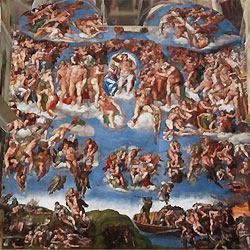 |
| Basilica of St. Peter. With an area covering 22.067 square meters on 186 meters length, the Basilica of San Pietro is the most imposing work of art in the Vatican City and the undisputed symbol of Rome. The Basilica of San Pietro was enlarged over the centuries with the contribution of artists such as Michelangelo, Baldassare Peruzzi, Donato Bramante, Gian Lorenzo Bernini, Raffaello, Antonio Sangallo. It was completed in 1614 and opened in 1626. The dome, 136 meters high with a diameter of 42, was the work of Michelangelo while the elliptic external piazza with flights of steps on three levels, and the quadruple colonnade connected to the basilica by two arms, is the work of Gianlorenzo Bernini. The interior is divided in three principle naves with a series of chapels, including the Chapel of the Relics, the Gregorian Chapel and the Chapel of the Column where the famous "Pietà" by Michelangelo can be found. The apse houses the spectacular bronze pulpit created by Bernini. |
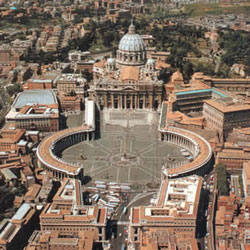 |